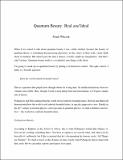Notice
This is not the latest version of this item. The latest version can be found at:https://dspace.mit.edu/handle/1721.1/137105.2
Quantum beauty: real and ideal
Author(s)
Wilczek, Frank
DownloadAccepted version (3.273Mb)
Open Access Policy
Open Access Policy
Creative Commons Attribution-Noncommercial-Share Alike
Terms of use
Metadata
Show full item recordAbstract
© Darwin College, 2013. When I was asked to talk about quantum beauty I was a little startled, because the beauty of quantum theory is something that practising physicists, in the course of their work, rarely think about or mention. But when I gave the idea a chance, it really caught my imagination. And that’s why I’m here. Quantum beauty really is a wonderful, true thing to talk about. I’m going to sneak up on quantum beauty by putting it in historical context. The right context, I think, is a broader question: Does the world embody beautiful ideas? That is a question that people have thought about for a long time. Its intellectual history deserves volumes and syllabi. Here, though, I want to keep things brief and entertaining, so I shall spin a simple tale of heroes. Pythagoras and Plato intuited that the world should embody beautiful ideas; Newton and Maxwell demonstrated how the world could embody beautiful ideas, in specific impressive cases. Finally, in the twentieth century in modern physics, and especially in quantum physics, we find a definitive answer: Yes! - the world does embody beautiful ideas.
Publisher
Cambridge University Press
Citation
Wilczek, Frank. "Quantum beauty: real and ideal."
Version: Author's final manuscript